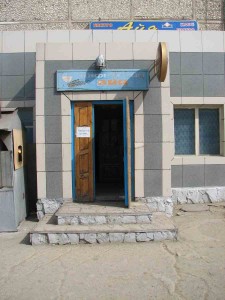Across from the Sharwa Bazaar was the café Aiya, where we’d had lunch with Zamzagul and Nariman just the day before.

With them, we’d sat in the smoky back and never looked at a menu. Now, we sat in the front room, equally smoky, and had one menu between us. One quick look, though, and I knew I was stumped. Cyrillic print was hard, but manageable. But this menu was in script; it might as well have been Greek.
“Order for me,” I asked my wordsmith husband, frustrated yet again. “I can’t make heads or tails out of this menu.”
“We’re probably safest with shashlik,” Woody decided and I nodded, just eager to eat and be away from the smoke.
Woody ordered a mutton shashlik and I decided on one made with liver. The skewered meat could be mutton, chicken, beef, or liver and I couldn’t tell whose liver I was eating: sheep, chicken, or cow. But it didn’t matter; served with thick slices of raw onion on the side and chunks of fresh white bread, it was delicious. There was a jar of vinegar on the table to sprinkle on the meat. We tried that too.
Then I got to try out my limited Russian. When Woody ordered his diet Pepsi — there was no Coke in Kazakhstan — I asked for a “meeneeral vadoo s’gasum” (mineral water with gas), part of my growing collection of useful phrases. I used it with glee, as much pleased with the sparkling water as I was grateful I didn’t have to drink a Pepsi.
Lunch over, Woody tried the universal sign language for the check — a quick check mark in the air and found it worked just fine. The waitress handed us a piece of scrap paper with 270 written on it in pencil. There’s no tipping in Kazakhstan, so no last minute math calculations. We read the numbers and handed over the tenge. Our lunch cost the equivalent of a dollar apiece.
Now this I particularly liked.
James Michener, the iconic author of such works as Hawaii, Alaska, Iberia, Mexico, Poland, and others, is quoted as saying, “If you reject the food, ignore the customs, fear the religion, and avoid the people, you might better stay home.” How about you? What exotic foods have you tried in your travels?
Marian Beaman
This brings back memories of the trying to decipher Cyrillic Russian alphabet during our stay in Ukraine. Regular print is hard enough, but adding the additional layer of script to the mix would really make the translation a challenge. Fortunately our host-guide was also our translator.
It sounds like your tentative Russian resulted in a tasty meal, for a totally delightful experience. Very upbeat – just the post I need for today.
Janet Givens
Hi Marian. So glad the post met your needs. Interesting for me to notice you made that distinction; I think too often I focus on the frustrations and I don’t offer the many times I was really excited and happy to be there, soaking up all the differences, all the newness. I also loved your image of the “additional level” of learning Russian; you are right, there are indeed levels. I’ll not soon forget my gasp when I realized that the letters of their alphabet were different in capital vs. lower case and in print vs. script. I had learned lower case and print during training. Suddently there were two additional sets of letters to memorize. Their small “m” turns into a “t” at some point; I remember that one. Thanks for dropping in. Another six weeks and the “non-deleted” scenes” will be available.